■ What is a Landgraff?
John Landgraff was a craftsman based in Florida, USA, who specialized in handmade pedals and customized guitar-related equipment. In Japan, Landgraff's work was first introduced at a musical instrument fair in the early 2000s. Notably, these products were displayed in glass cases, likely preventing attendees from trying them out at the time.
In a previous article on distortion pedals, I briefly mentioned Landgraff. Here, I’d like to delve deeper into his work.
Landgraff handcrafted compact pedals, including the Dynamic Overdrive (DOD), MOD Distortion (MOD), Distortion BOX (BOX), Clean Boosters, and Blues Boxes, among others.
Unfortunately, Landgraff has since passed away. It's estimated that around 2,500 DOD units were produced during his lifetime. His wife eventually joined him in the manufacturing process.
Notably, the enthusiastic handwritten messages on the pedal backplates transitioned from cursive to block letters as they began exporting to Japan. Over time, the backplates even bore the names of both Landgraff and his wife.
Landgraff's workshop was a small, agile operation characteristic of handmade manufacturing.
Among his custom creations, there were even oversized models twice the typical size. When such rare pedals appear on online marketplaces today, they sell almost instantly.
Landgraff also worked on amp modifications. Over the past year, at least one modified Landgraff amp has been spotted in the Japanese market, only to sell just as quickly. It’s a pity that he couldn't dedicate more of his time to amp customizations.
Landgraff's legacy as a craftsman lives on, with his work remaining highly sought after by musicians and collectors worldwide.
■ 20 Years Ago, I Was Stuck in the 'Distortion Obsession
Shortly after buying my first electric guitar, I got my hands on two classics: the BOSS Super OverDrive SD-1 and the Distortion DS-1.
For a few years, I played them relentlessly, formed a band, and eventually explored more of BOSS’s distortion lineup, including the Turbo OverDrive OD-2, OD-3, and Blues Driver BD-2. As my ear became more discerning, I started hunting for gear that received high praise in magazines—both domestic and international distortion pedals recommended by others. I ended up buying pedal after pedal.
Today, the market is flooded with high-quality, handmade distortion pedals, but their prices have skyrocketed to unprecedented levels. Take the Klon Centaur, for example—it's become more like an investment than a piece of gear. Some units are selling for over ten times their original price since their release. (Based on market prices as of summer 2022.)
■ So, Why Did I Decide to Buy a DOD?
It was because the tone produced by professional guitarists using the DOD was close to my ideal sound. Moreover, Landgraff pedals didn’t just deliver exceptional sound quality—their prices were outrageously high, which ironically became a unique selling point. Even the name "Landgraff" had a powerful, striking quality that drew me in.
■ The Encounter
Each Landgraff pedal boasts a unique design, with their signature marble paint jobs crafted by a man named Aaron Prince. I discovered a used DOD in stock while browsing online and headed to a music shop located slightly outside the Ochanomizu area.
The first DOD I laid eyes on, pulled from the shop’s display case, was nothing short of divine—a red-and-gold painted marvel (see photo). I asked the store clerk to take it out of its glass case and also brought out another unit for comparison.
Before diving into the genuine DOD, I first tested a domestic copy model featuring a three-mode design in a soundproof room, giving it a full workout to get a sense of the differences.

Red DOD 800 Series: “Two Shots of the Full Exterior”
I’ve owned this pedal for over 10 years now and still use it regularly. Although the level knob produces a slight scratchy noise, it remains a cherished part of my gear collection.
Next, I tried out the Landgraff distortion. The distortion, tone, and sonic sheen were remarkably well-balanced. To put it simply, it had the alluring tonal presence that stands out even among other high-end foreign-made pedals. It felt like it was tuned to a higher level of refinement, with particularly outstanding articulation and clarity (based on my personal impression). I was fortunate enough to acquire it for less than half the 2022 market price.
■ A Decade with the DOD
Over the years, I went through a cycle of buying, selling, and repurchasing distortion pedals, constantly seeking the perfect tone. Eventually, I managed to escape the “distortion obsession,” and even now, the Landgraff remains a permanent fixture in my guitar case, always ready for action.
For guitarists wondering, “What exactly is the Landgraff pedal I hold in such high regard?” let me explain its sound in detail once more.
■ The Concept of the DOD
The Landgraff’s flagship model, the DOD, is an overdrive pedal inspired by classics like the Ibanez Tube Screamer. Some guitarists familiar with circuits might dismiss it, saying, “It’s just a Tube Screamer with a few altered components.” However, I firmly believe it’s something entirely different.
Let me explain with an analogy:
Imagine gathering three master chefs and giving them the same ingredients to make soup.
While they’d all be using identical ingredients, the flavors would vary based on their individual skills and methods.
Similarly, even if a pedal uses the same components, the sound will undoubtedly differ depending on the designer and builder.
That said, preferences vary greatly among guitarists. Some may feel, “Landgraff is just overpriced hype,” and that’s valid. Taste in distortion is deeply personal and diverse.
The DOD’s controls include Drive, Tone, and Level, arranged from left to right. It also features a mini-switch with three modes:
- Top position: Marshall mode
- Middle position: Dumble mode
- Bottom position: Tube Screamer mode
Notably, the original English translation provided by the distributor, Tahara, mistakenly listed the modes as Dumble, Marshall, and Tube Screamer (from top to bottom), which was incorrect.
■ Sound and Features
The DOD boasts a bold dynamic range while maintaining an elegant tone. Even under heavy distortion, it remains smooth and controlled, exuding a luxurious quality. Its detailed and rich sound makes it versatile for various settings—whether at home, in the studio, or live performances. The tonal allure, with its sheen and expansive quality, has a distinct character that's difficult to replicate, especially for Japanese manufacturers.
While it might not cater to the heavily saturated distortion styles that became prominent after the 1990s, it’s more than capable for hard rock. According to the instruction manual from distributor Tahara, setting the mini-switch to the middle (Dumble mode), lowering the gain, and raising the volume should provide a clean boost in the mid-lows. I tested this, but the boost effect wasn’t particularly dramatic.
My favorite switch position is the middle Dumble mode. The pronounced mids are so compelling that I couldn’t help but think, “This is the Landgraff sound!” as I played it at high volume. It’s deeply original and richly layered. The sound is reminiscent of the engine of a powerful aluminum bomber—bold and thrilling.
For small venue performances, setting the Level knob around 8 to 9 o’clock is sufficient to draw the perfect sound from the guitar. Even at low volumes suitable for a household environment, the DOD delivers impressive results. It competes well with today’s low-wattage tube amps in the 1W to 5W range.
■ Important Notes for Using the Landgraff
After testing several compact effects pedals by Landgraff, aside from the Blues Box, I noticed a common caution across the three distortion models—DOD, MOD, and BOX. This is especially critical during live performances, where a mistake could leave a poor impression.
The issue is this: when switching the mini-switch from the bottom Tube Screamer mode to the middle Dumble mode or Marshall mode, if you forget to lower the Level knob beforehand and leave it turned up, the resulting volume spike can be massive. This sudden increase in volume may damage a tube amplifier, possibly even causing it to break. Worse still, it can irritate the audience, which is something a professional guitarist should avoid at all costs.
This isn’t a defect—it’s simply how the pedal is designed, with a significant volume jump built into these modes. It’s the single most important point to remember when using a Landgraff. Handle with care and always check your settings!
■ Landgraff Maintenance and Build Quality
While Landgraff’s handwritten messages for owners don’t dwell much on maintenance, his pedals are constructed with no expense spared. He used premium components, including high-grade parts typically found in high-end audio equipment. Even the switches were carefully selected for durability, opting for analog switches that stand the test of time rather than lighter, less robust options. From my experience, the switches in Landgraff pedals are as sturdy as those used by the American brand Fulltone, known for its rugged build quality (see photo).
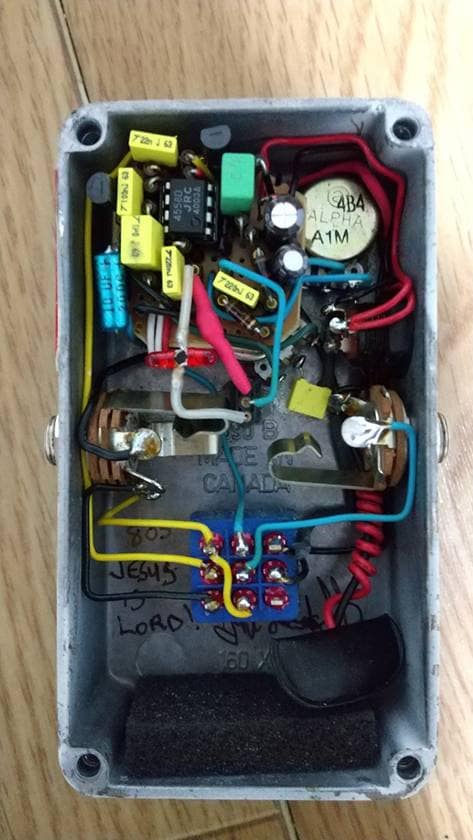
Internal Full View Photo of the Landgraff Dynamic Overdrive
Another important point to note is that the knobs may loosen over time. If you notice any looseness, it's best to address it before it becomes wobbly. Remove the knob and tighten the underlying part using a tool. For those who aren’t confident in their dexterity, it’s wise to consult a professional repair technician, especially given the high value of these pedals.
Even though high-end components are used, if the three knobs are left unused for extended periods, they may develop scratchy noise (static), just like any other pedal.
Additionally, based on my personal experience, the DOD seems to consume batteries slightly faster than standard overdrive pedals.
For those purchasing a used unit, one way to gauge how much the previous owner used it is by inspecting the wear on the tip of the internal jack. This can easily indicate the level of use. Clean the contact points with a cotton swab and cleaning solution to remove any dirt. If noise persists, a jack replacement may be necessary. However, since pedals don’t receive the same frequent handling as guitars, this is rarely a major concern for me.
Incidentally, DOD pedals were sold for about six months to a year on Soundhouse in the past.
■ Additional Features of the Sound
Based on my experience, the tonal characteristics of Landgraff pedals evolve noticeably depending on the production period.
- Early models: The sound can be summed up in one word—powerful.
- Mid-series (several hundred units and later): The distortion becomes richer and more refined.
- Late-series models: The sound tends to blend power with depth, achieving a unique balance.
While these descriptions are approximations, it’s evident that the sound has shifted over time with the evolution of the product.
At the heart of the pedal is the JRC4558 IC chip, a crucial component with subtle numerical variations from one unit to another that can influence the tone. Inside the pedal, components are arranged vertically on a compact square circuit board. The soldering is done using silver solder, reflecting a dedication to quality.
All these elements contribute to a level of originality that was unprecedented at the time.
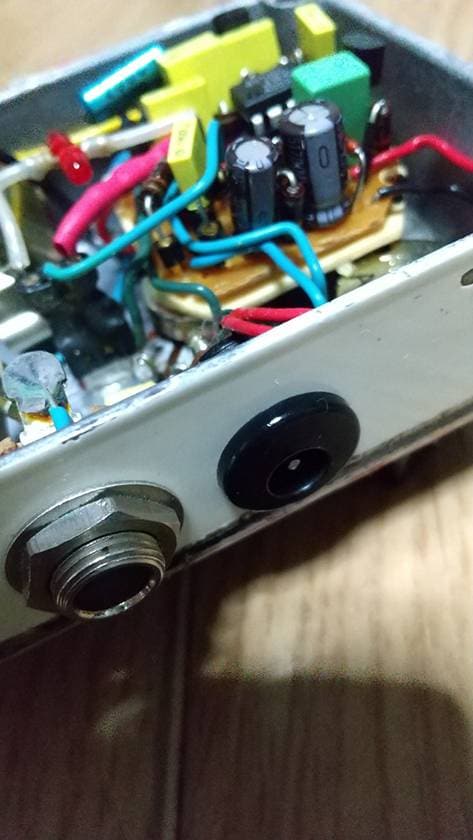
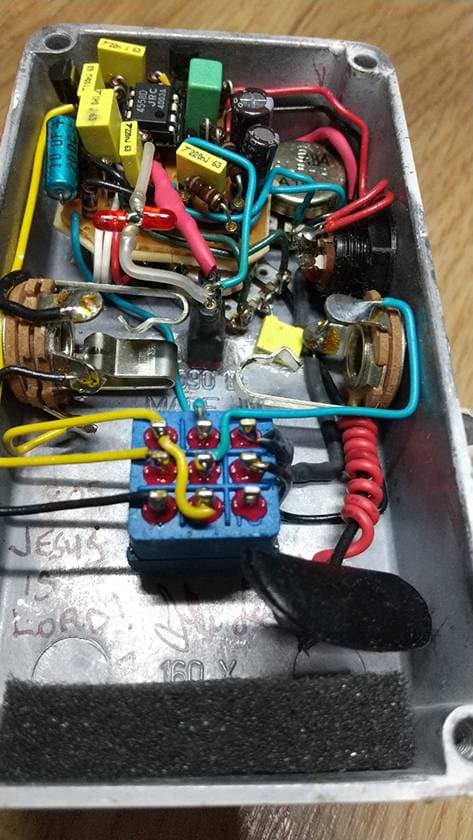
Looking at the DOD circuit board from a slightly lower angle reveals how the components are vertically arranged.
Each Landgraff pedal features a unique exterior design, so if you come across one that matches your personal taste, it might be worth buying. Since the pedal’s paint is something you’ll see every time you play your guitar (unless it’s rack-mounted), putting some thought into the design is worthwhile. Notably, blue-painted models were among those that disappeared from the market around last year.
On the back of the pedal, Landgraff’s signature is typically present. The style of his handwriting varies by production period:
- Early models: Bold and strong lettering.
- Mid-period: Fine and delicate writing.
- Post-2010: Generally thin letters.
- Late years: Likely due to health issues, the signatures are bold but often shaky.
■ In Conclusion
It’s certain that Landgraff pedals will continue to diminish in availability on the market—they aren’t being produced anymore, and their numbers won’t increase. Developing pedals of such outstanding quality will also take considerable time.
For those looking for excellent sound without venturing into ultra-high price ranges, I’d recommend considering currently available options like the MAD PROFESSOR "Royal Blue Overdrive Factory".
MAD PROFESSOR / Royal Blue Overdrive Factory
This pedal, offered by MAD PROFESSOR, is more affordable because it’s not a handmade version, yet it can double as a clean boost if the gain is set to zero.
While their "Sweet Honey Overdrive Factory" is more well-known, I specifically recommend the "Royal Blue Overdrive Factory".
Key features:
- A wide range of distortion, with a dynamic range comparable to the DOD.
- Responsive to picking dynamics, offering a versatile and nuanced distortion.
- A stylish design—its deep, rich blue color evokes the vibe of Liberty Department Store in the UK.
Instead of buying two mass-produced pedals, investing in this single unit is a worthwhile choice!
The “sound & person” column is made up of contributions from you.
For details about contributing, click here.





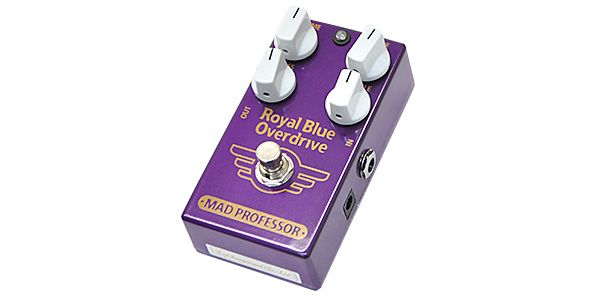


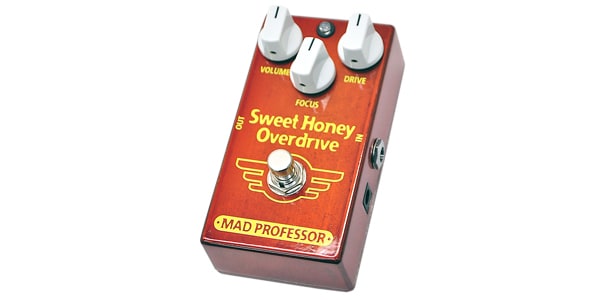





![[New for 2025] Top 10 Recommended Overdrive Pedals!](/contents/uploads/thumbs/2/2022/8/20220801_2_18812_1.jpg)
![[Latest for 2025] The 10 Best Effects Pedals for Guitar Beginners!](/contents/uploads/thumbs/2/2022/5/20220526_2_18129_1.jpg)
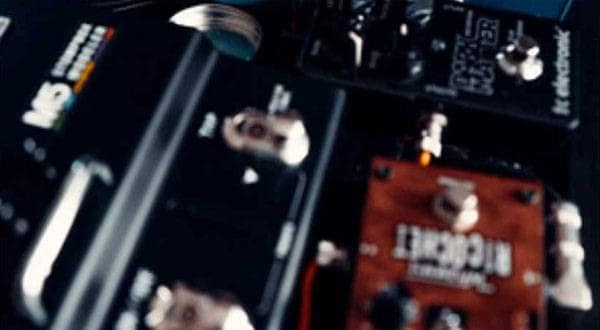

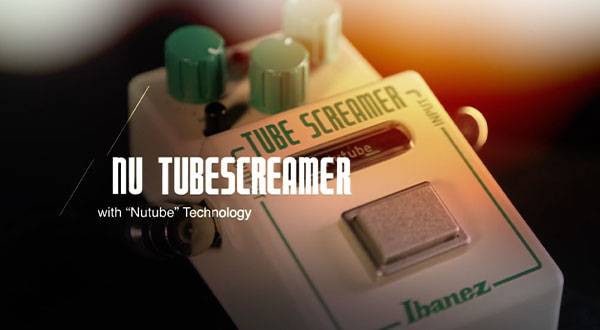
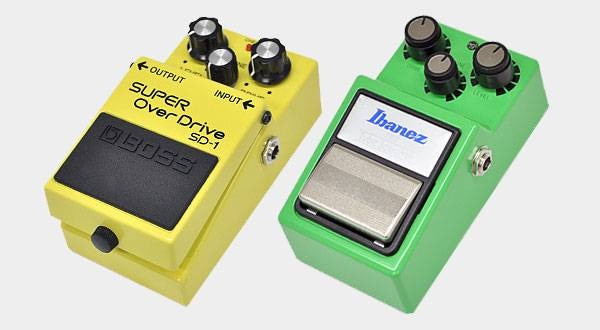
 第2弾 あなたのエフェクターボード見せてください
第2弾 あなたのエフェクターボード見せてください
 【初心者向け】エフェクター講座
【初心者向け】エフェクター講座
 あなたのエフェクターボード見せてください
あなたのエフェクターボード見せてください
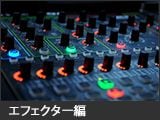 エフェクター編
エフェクター編
 エフェクターのつなぎ方
エフェクターのつなぎ方
 エフェクターの種類
エフェクターの種類















